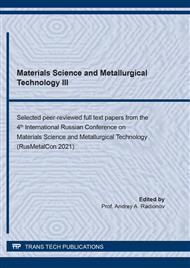[1]
N. Lv, J. Zhong, H. Chen, S. Chen, Real-time control of welding penetration during robotic GTAW dynamical process by audio sensing of arc length, The International Journal of Advanced Manufacturing Technology. 74(1-4) (2014) 235-249.
DOI: 10.1007/s00170-014-5875-7
Google Scholar
[2]
C. Chen, R. Xiao, H. Chen, N. Lv, Arc sound model for pulsed GTAW and recognition of different penetration states, The International Journal of Advanced Manufacturing Technology. 108 (2020) 3175-3191.
DOI: 10.1007/s00170-020-05462-z
Google Scholar
[3]
D. Shatagin, A. Galkin, A.N. Osmehin, N. Klochkova, Cyber-physical hybrid processing system digital twin, Materials Science Forum. 1037 (2021) 119-124.
DOI: 10.4028/www.scientific.net/msf.1037.119
Google Scholar
[4]
Yu.G. Kabaldin, D.A. Shatagin, M.S. Anosov, P.V. Kolchin, A.V. Kiselev, Diagnostics of the 30-print process on a CNC machine using machine learning approaches, Vestnik Mashinostroyeniya, 1 (2021) 55-59.
DOI: 10.36652/0042-4633-2021-1-55-59
Google Scholar
[5]
I.V. Pentegov, V.N. Sidorets, Comparative analysis of models of dynamic welding arc, Automatic Welding. 2 (1989) 33-36.
Google Scholar
[6]
E.N. Vereshchago, V.I. Kostyuchenko, Model of the electric arc in Matlab / Simulink, Electrical Engineering and Power Engineering. 2 (2013) 40-46.
Google Scholar
[7]
A. Savitsky, M. Haltof, Problems of determining the parameters of mathematical models of electric arcs in circuits with current sources, Electricity. 1 (2016) 25-34.
Google Scholar
[8]
Information on: https://github.com/ranalytics/data-mining.
Google Scholar
[9]
Information on: https://ru.wikipedia.org/wiki/Random_forest.
Google Scholar
[10]
J. Gonzalez, W. Yu, Non-linear system modeling using LSTM neural networks, IFAC-PapersOnLine. 51(13) (2018) 485-489.
DOI: 10.1016/j.ifacol.2018.07.326
Google Scholar
[11]
Information on: https://en.wikipedia.org/wiki/Long_short-term_memory.
Google Scholar
[12]
D. Eck, J. Schmidhuber, Learning the long-term structure of the blues, in: 12th International Conference on Artifical Neural Networks (ICANN 2002), Lecture Notes in Computer Science, 2415, Springer, Berlin, Heidelberg, pp.284-289.
DOI: 10.1007/3-540-46084-5_47
Google Scholar
[13]
J. Schmidhuber, F. Gers, D. Eck, Learning nonregular languages: A comparison of simple recurrent networks and LSTM, Neural Computation. 14(9) (2002) 2039-2041.
DOI: 10.1162/089976602320263980
Google Scholar
[14]
A. Graves, J. Schmidhuber, Framewise phoneme classification with bidirectional LSTM and other neural network architectures, Neural Networks. 18(5-6) (2005) 602-610.
DOI: 10.1016/j.neunet.2005.06.042
Google Scholar
[15]
P. Malhotra, L. Vig, G. Shroff, P. Agarwal, Long short term memory networks for anomaly detection in time series, 23rd European Symposium on Artificial Neural Networks, Computational Intelligence and Machine Learning, ESANN, Bruges, Belgium, (2015).
Google Scholar


